双宾语vs宾语和宾语补足语
- 格式:docx
- 大小:12.27 KB
- 文档页数:2
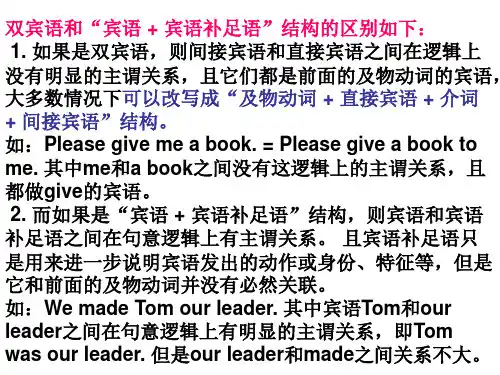
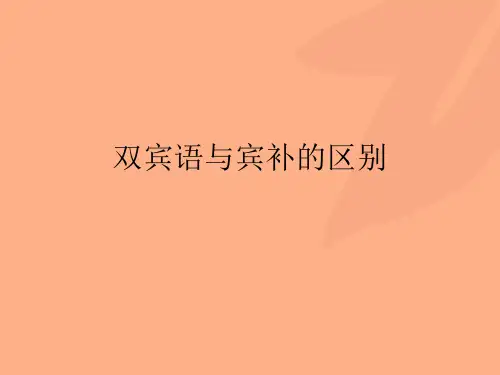
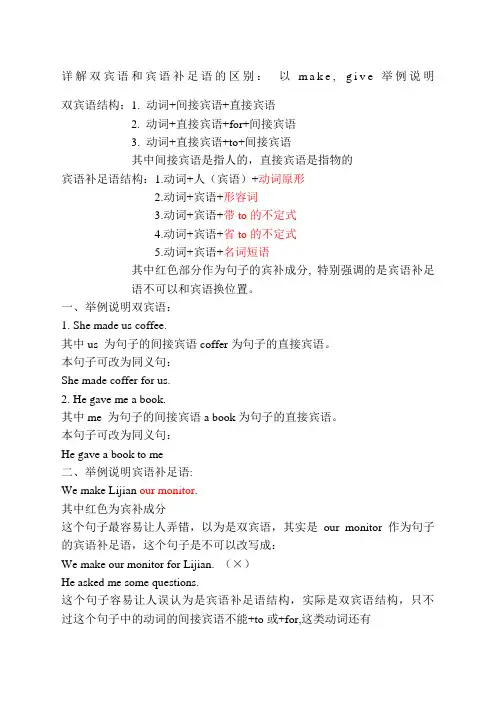
详解双宾语和宾语补足语的区别:以m a k e,g i v e举例说明双宾语结构:1. 动词+间接宾语+直接宾语2. 动词+直接宾语+for+间接宾语3. 动词+直接宾语+to+间接宾语其中间接宾语是指人的,直接宾语是指物的宾语补足语结构:1.动词+人(宾语)+动词原形2.动词+宾语+形容词3.动词+宾语+带to的不定式4.动词+宾语+省to的不定式5.动词+宾语+名词短语其中红色部分作为句子的宾补成分, 特别强调的是宾语补足语不可以和宾语换位置。
一、举例说明双宾语:1. She made us coffee.其中us 为句子的间接宾语coffer为句子的直接宾语。
本句子可改为同义句:She made coffer for us.2. He gave me a book.其中me 为句子的间接宾语a book为句子的直接宾语。
本句子可改为同义句:He gave a book to me二、举例说明宾语补足语:We make Lijian our monitor.其中红色为宾补成分这个句子最容易让人弄错,以为是双宾语,其实是our monitor作为句子的宾语补足语,这个句子是不可以改写成:We make our monitor for Lijian. (×)He asked me some questions.这个句子容易让人误认为是宾语补足语结构,实际是双宾语结构,只不过这个句子中的动词的间接宾语不能+to或+for,这类动词还有cost, refuse, promiseThe book cost me five yuan.三、动词+直接宾语+for+间接宾语,这种结构中能用for改为同义句的动词有:buy, play, make, find,keep,choose,cut,cook,wash等Please cut Tom the cake.= Please cut the cake for Tom.My father often washes me the clothes.=My father often washes the clothes for me.My father often cooks me lunch.=My father often cooks lunch for me.四、动词+直接宾语+to+间接宾语,这种结构中能用to改为同义句的动词有:七给give, hand, pass, lend, send, show, write,一带bring,还有pay, teach, tell, wish, return, sell, read,等I returned him the storybook= I returned the storybook to him.He showed all his friends his pictures.= He showed his pictures to all his friends.He sent me a book.= He sent a book to me。
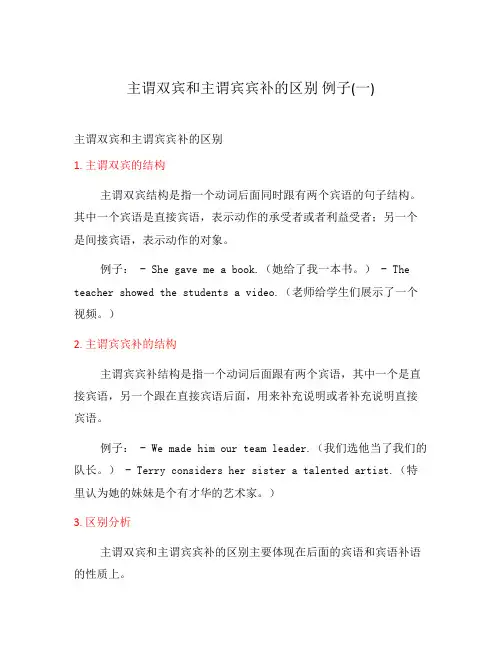
主谓双宾和主谓宾宾补的区别例子(一)主谓双宾和主谓宾宾补的区别1. 主谓双宾的结构主谓双宾结构是指一个动词后面同时跟有两个宾语的句子结构。
其中一个宾语是直接宾语,表示动作的承受者或者利益受者;另一个是间接宾语,表示动作的对象。
例子: - She gave me a book.(她给了我一本书。
) - The teacher showed the students a video.(老师给学生们展示了一个视频。
)2. 主谓宾宾补的结构主谓宾宾补结构是指一个动词后面跟有两个宾语,其中一个是直接宾语,另一个跟在直接宾语后面,用来补充说明或者补充说明直接宾语。
例子: - We made him our team leader.(我们选他当了我们的队长。
) - Terry considers her sister a talented artist.(特里认为她的妹妹是个有才华的艺术家。
)3. 区别分析主谓双宾和主谓宾宾补的区别主要体现在后面的宾语和宾语补语的性质上。
•主谓双宾结构中,直接宾语和间接宾语都是表示动作的对象或者受益者。
直接宾语通常回答“谁”或者“什么”,而间接宾语回答“给谁”或者“对谁”。
•主谓宾宾补结构中,直接宾语表示动作的对象,而宾语补语则是对直接宾语的补充说明或者进一步详细说明。
4. 总结在使用主谓双宾和主谓宾宾补的句子结构时,需要注意宾语的性质和用法。
主谓双宾结构中,直接宾语和间接宾语都是表示动作的对象或者受益者;而主谓宾宾补结构中,宾语补语是对直接宾语的补充说明或者进一步详细说明。
正确理解和运用这两种句子结构,可以帮助我们表达清晰准确的意思。
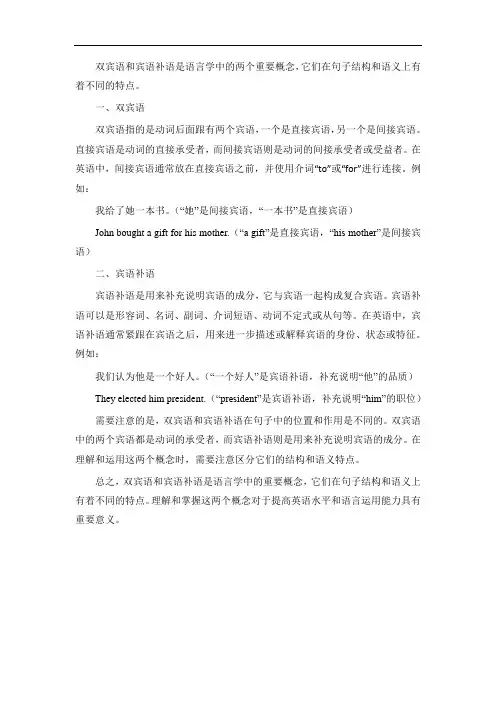
双宾语和宾语补语是语言学中的两个重要概念,它们在句子结构和语义上有着不同的特点。
一、双宾语
双宾语指的是动词后面跟有两个宾语,一个是直接宾语,另一个是间接宾语。
直接宾语是动词的直接承受者,而间接宾语则是动词的间接承受者或受益者。
在英语中,间接宾语通常放在直接宾语之前,并使用介词“to”或“for”进行连接。
例如:
我给了她一本书。
(“她”是间接宾语,“一本书”是直接宾语)
John bought a gift for his mother.(“a gift”是直接宾语,“his mother”是间接宾语)
二、宾语补语
宾语补语是用来补充说明宾语的成分,它与宾语一起构成复合宾语。
宾语补语可以是形容词、名词、副词、介词短语、动词不定式或从句等。
在英语中,宾语补语通常紧跟在宾语之后,用来进一步描述或解释宾语的身份、状态或特征。
例如:
我们认为他是一个好人。
(“一个好人”是宾语补语,补充说明“他”的品质)They elected him president.(“president”是宾语补语,补充说明“him”的职位)需要注意的是,双宾语和宾语补语在句子中的位置和作用是不同的。
双宾语中的两个宾语都是动词的承受者,而宾语补语则是用来补充说明宾语的成分。
在理解和运用这两个概念时,需要注意区分它们的结构和语义特点。
总之,双宾语和宾语补语是语言学中的重要概念,它们在句子结构和语义上有着不同的特点。
理解和掌握这两个概念对于提高英语水平和语言运用能力具有重要意义。
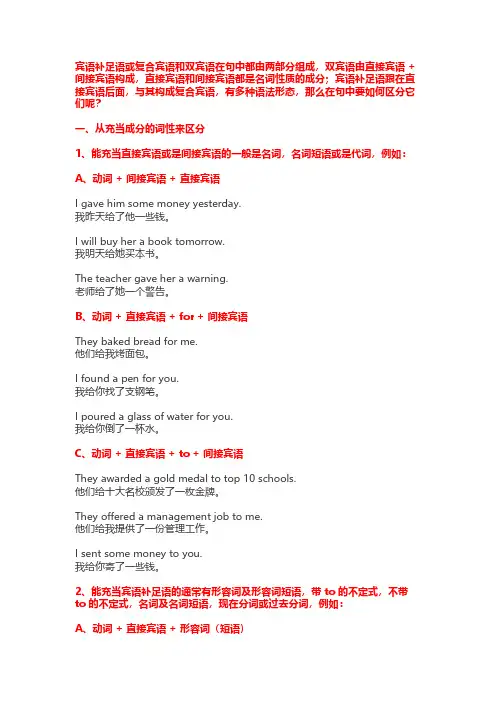
宾语补足语或复合宾语和双宾语在句中都由两部分组成,双宾语由直接宾语 + 间接宾语构成,直接宾语和间接宾语都是名词性质的成分;宾语补足语跟在直接宾语后面,与其构成复合宾语,有多种语法形态,那么在句中要如何区分它们呢?一、从充当成分的词性来区分1、能充当直接宾语或是间接宾语的一般是名词,名词短语或是代词,例如:A、动词 + 间接宾语 + 直接宾语I gave him some money yesterday.我昨天给了他一些钱。
I will buy her a book tomorrow.我明天给她买本书。
The teacher gave her a warning.老师给了她一个警告。
B、动词 + 直接宾语 + for + 间接宾语They baked bread for me.他们给我烤面包。
I found a pen for you.我给你找了支钢笔。
I poured a glass of water for you.我给你倒了一杯水。
C、动词 + 直接宾语 + to + 间接宾语They awarded a gold medal to top 10 schools.他们给十大名校颁发了一枚金牌。
They offered a management job to me.他们给我提供了一份管理工作。
I sent some money to you.我给你寄了一些钱。
2、能充当宾语补足语的通常有形容词及形容词短语,带 to 的不定式,不带to 的不定式,名词及名词短语,现在分词或过去分词,例如:A、动词 + 直接宾语 + 形容词(短语)We all consider her unworthy.我们都认为她不值的。
The evidence proved the accused innocent.证据证明被告无罪。
My husband and I painted our living room lime green. 我和丈夫把客厅漆成了青柠色。
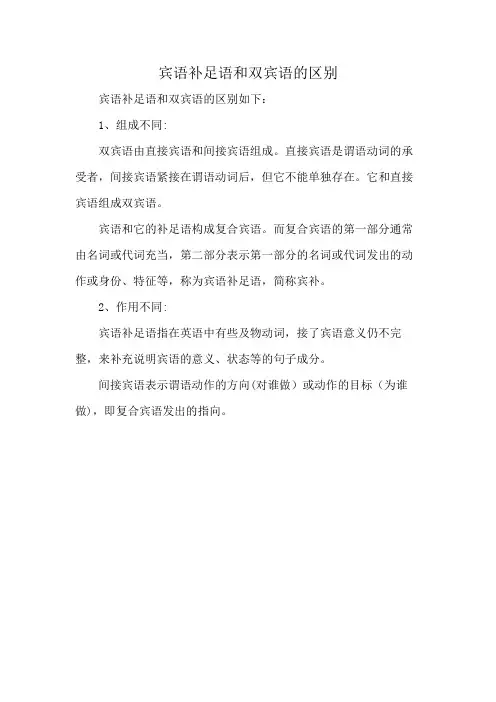
宾语补足语和双宾语的区别
宾语补足语和双宾语的区别如下:
1、组成不同:
双宾语由直接宾语和间接宾语组成。
直接宾语是谓语动词的承受者,间接宾语紧接在谓语动词后,但它不能单独存在。
它和直接宾语组成双宾语。
宾语和它的补足语构成复合宾语。
而复合宾语的第一部分通常由名词或代词充当,第二部分表示第一部分的名词或代词发出的动作或身份、特征等,称为宾语补足语,简称宾补。
2、作用不同:
宾语补足语指在英语中有些及物动词,接了宾语意义仍不完整,来补充说明宾语的意义、状态等的句子成分。
间接宾语表示谓语动作的方向(对谁做)或动作的目标(为谁做),即复合宾语发出的指向。
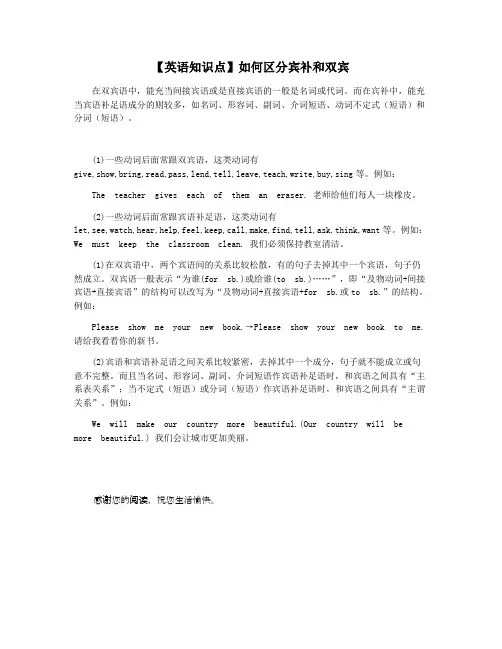
【英语知识点】如何区分宾补和双宾在双宾语中,能充当间接宾语或是直接宾语的一般是名词或代词。
而在宾补中,能充当宾语补足语成分的则较多,如名词、形容词、副词、介词短语、动词不定式(短语)和分词(短语)。
(1)一些动词后面常跟双宾语,这类动词有give,show,bring,read,pass,lend,tell,leave,teach,write,buy,sing等。
例如:The teacher gives each of them an eraser. 老师给他们每人一块橡皮。
(2)一些动词后面常跟宾语补足语,这类动词有let,see,watch,hear,help,feel,keep,call,make,find,tell,ask,think,want等。
例如:We must keep the classroom clean. 我们必须保持教室清洁。
(1)在双宾语中,两个宾语间的关系比较松散,有的句子去掉其中一个宾语,句子仍然成立。
双宾语一般表示“为谁(for sb.)或给谁(to sb.)……”,即“及物动词+间接宾语+直接宾语”的结构可以改写为“及物动词+直接宾语+for sb.或to sb.”的结构。
例如:Please show me your new book.→Please show your new book to me. 请给我看看你的新书。
(2)宾语和宾语补足语之间关系比较紧密,去掉其中一个成分,句子就不能成立或句意不完整。
而且当名词、形容词、副词、介词短语作宾语补足语时,和宾语之间具有“主系表关系”;当不定式(短语)或分词(短语)作宾语补足语时,和宾语之间具有“主谓关系”。
例如:We will make our country more beautiful.(Our country will be more beautiful.) 我们会让城市更加美丽。
感谢您的阅读,祝您生活愉快。
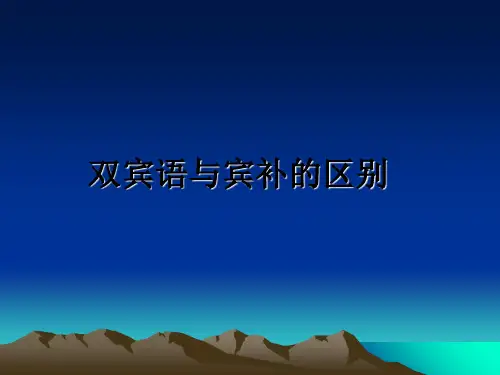
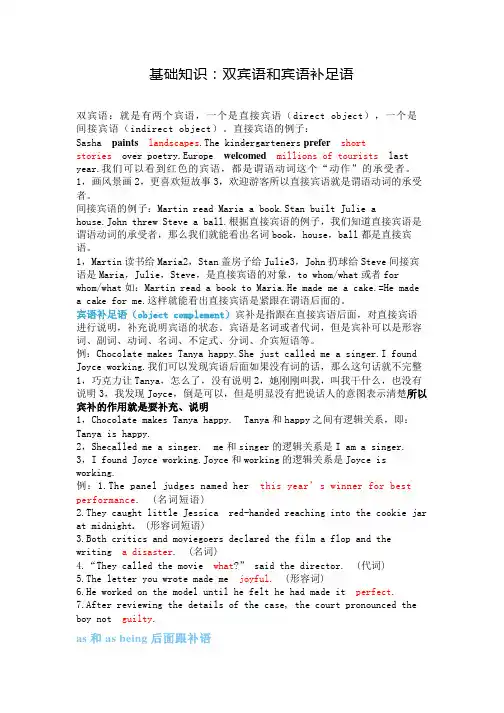
基础知识:双宾语和宾语补足语双宾语:就是有两个宾语,一个是直接宾语(direct object),一个是间接宾语(indirect object)。
直接宾语的例子:Sasha paints landscapes.The kindergarteners prefer shortstories over poetry.Europe welcomed millions of tourists last year.我们可以看到红色的宾语,都是谓语动词这个“动作”的承受者。
1,画风景画2,更喜欢短故事3,欢迎游客所以直接宾语就是谓语动词的承受者。
间接宾语的例子:Martin read Maria a book.Stan built Julie ahouse.John threw Steve a ball.根据直接宾语的例子,我们知道直接宾语是谓语动词的承受者,那么我们就能看出名词book,house,ball都是直接宾语。
1,Martin读书给Maria2,Stan盖房子给Julie3,John扔球给Steve间接宾语是Maria,Julie,Steve,是直接宾语的对象,to whom/what或者for whom/what如:Martin read a book to Maria.He made me a cake.=He made a cake for me.这样就能看出直接宾语是紧跟在谓语后面的。
宾语补足语(object complement)宾补是指跟在直接宾语后面,对直接宾语进行说明,补充说明宾语的状态。
宾语是名词或者代词,但是宾补可以是形容词、副词、动词、名词、不定式、分词、介宾短语等。
例:Chocolate makes Tanya happy.She just called me a singer.I found Joyce working.我们可以发现宾语后面如果没有词的话,那么这句话就不完整1,巧克力让Tanya,怎么了,没有说明2,她刚刚叫我,叫我干什么,也没有说明3,我发现Joyce,倒是可以,但是明显没有把说话人的意图表示清楚所以宾补的作用就是要补充、说明1,Chocolate makes Tanya happy. Tanya和happy之间有逻辑关系,即:Tanya is happy.2,Shecalled me a singer. me和singer的逻辑关系是I am a singer.3,I found Joyce working.Joyce和working的逻辑关系是Joyce is working.例:1.The panel judges named her this year’s winner for best performance. (名词短语)2.They caught little Jessica red-handed reaching into the cookie jar at midnight.(形容词短语)3.Both critics and moviegoers declared the film a flop and thewriting a disaster. (名词)4.“They called the movie what?” said the director.(代词)5.The letter you wrote made me joyful. (形容词)6.He worked on the model until he felt he had made it perfect.7.After reviewing the details of the case, the court pronounced the boy not guilty.as和as being后面跟补语动词+宾语+as (being) +补语asI think of the government as useless.She declared the dish as delicious as a five-star meal.The judges regard him as worthy of the prize.He described his wife as loyal, loving and faithful.as beingHe sees the car as being a classic beauty.They consider him as being a very smart person.She sees him as being emotionally draining.The teacher regards him as being disruptive in class.宾语补足语和主语补足语宾补:是对宾语的补充主补:是对主语的补充宾补与宾语在逻辑上有主谓关系如:You should keep the window open.open是对宾语window的补充the window is open是逻辑上的主谓关系主补与主语也有逻辑上的主谓关系如:The window should be kept open.She was elected chairman of Students’ Union.把这句写成主动语态:We elected her chairman of Students’ Union从上面的例句看出,主补通常在被动语态中,宾语变主语,宾补变主补。
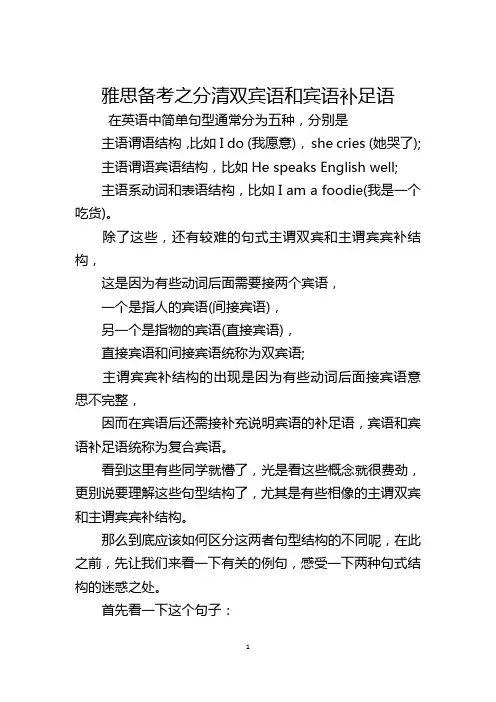
雅思备考之分清双宾语和宾语补足语在英语中简单句型通常分为五种,分别是主语谓语结构,比如I do (我愿意),she cries (她哭了);主语谓语宾语结构,比如He speaks English well;主语系动词和表语结构,比如I am a foodie(我是一个吃货)。
除了这些,还有较难的句式主谓双宾和主谓宾宾补结构,这是因为有些动词后面需要接两个宾语,一个是指人的宾语(间接宾语),另一个是指物的宾语(直接宾语),直接宾语和间接宾语统称为双宾语;主谓宾宾补结构的出现是因为有些动词后面接宾语意思不完整,因而在宾语后还需接补充说明宾语的补足语,宾语和宾语补足语统称为复合宾语。
看到这里有些同学就懵了,光是看这些概念就很费劲,更别说要理解这些句型结构了,尤其是有些相像的主谓双宾和主谓宾宾补结构。
那么到底应该如何区分这两者句型结构的不同呢,在此之前,先让我们来看一下有关的例句,感受一下两种句式结构的迷惑之处。
首先看一下这个句子:I recommended my favorite movie to my cousin (我把我最喜欢的电影推荐给我表弟了)。
在这句话中,my favorite movie 和my cousin 同时做recommend的宾语,一般我们把表示人的宾语叫做间接宾语,表示物的宾语叫做直接宾语,所以这句话就是主语(I)+ 谓语(recommended) +直接宾语(my favorite movie)+ 间接宾语(my cousin)的结构。
同样的句式还有:He(主语) shows(谓语) his passport(直接宾语) to his sister(间接宾语)。
我们总结一下,一般这种接双宾语的常用动词有assign, award, bring, deliver, deny, feed, give, hand, lend, offer, pass, pay, read, promise, recommend, sell, send, show, take, write...说完了主语谓语双宾语结构,我们现在来看一下主谓宾宾补结构,之前已经说过,有些动词后面接宾语意思不完整,因而在宾语后还需接补充说明宾语的补足语。
1详解双宾语和宾语补足语的区别:以make, give举例说明欧阳歌谷(2021.02.01)双宾语结构:1. 动词+间接宾语+直接宾语2. 动词+直接宾语+for+间接宾语3. 动词+直接宾语+to+间接宾语其中间接宾语是指人的,直接宾语是指物的宾语补足语结构:1.动词+人(宾语)+动词原形2.动词+宾语+形容词3.动词+宾语+带to的不定式4.动词+宾语+省to的不定式5.动词+宾语+名词短语其中红色部分作为句子的宾补成分, 特别强调的是宾语补足语不可以和宾语换位置。
一、举例说明双宾语:1. She made us coffee.其中us 为句子的间接宾语coffer为句子的直接宾语。
本句子可改为同义句:She made coffer for us.2. He gave me a book.其中me 为句子的间接宾语a book为句子的直接宾语。
本句子可改为同义句:He gave a book to me二、举例说明宾语补足语:We make Lijian our monitor.其中红色为宾补成分这个句子最容易让人弄错,以为是双宾语,其实是our monitor作为句子的宾语补足语,这个句子是不可以改写成:We make our monitor for Lijian. (×)1He asked me some questions.这个句子容易让人误认为是宾语补足语结构,实际是双宾语结构,只不过这个句子中的动词的间接宾语不能+to或+for,这类动词还有cost, refuse, promiseThe book cost me five yuan.三、动词+直接宾语+for+间接宾语,这种结构中能用for改为同义句的动词有:buy, play, make, find,keep,choose,cut,cook,wash等Please cut Tom the cake.= Please cut the cake for Tom.My father often washes me the clothes.=My father often washes the clothes for me.My father often cooks me lunch.=My father often cooks lunch for me.四、动词+直接宾语+to+间接宾语,这种结构中能用to改为同义句的动词有:七给give, hand, pass, lend, send, show, write,一带bring,还有pay, teach,tell,wish,return, sell, read,等I returned him the storybook= I returned the storybook to him.He showed all his friends his pictures.= He showed his pictures to all his friends.He sent me a book.= He sent a book to me。
双宾语和宾语补足语
双宾语和宾语补足语都是在句子中作为动词的补足成分出现的,但是它们的作用和形式不同。
双宾语是指某些动词可以接受两个宾语,一个直接宾语和一个间接宾语,常见的这类动词有give、buy、show、bring等。
例如:- She gave me a book.(她给了我一本书。
)。
- He bought his daughter a toy.(他给他的女儿买了一个玩具。
)。
- I'll bring you some coffee.(我给你拿杯咖啡。
)。
- She makes me happy.(她让我感到快乐。
)(宾语补足语为形容词happy)。
- He keeps his promises.(他遵守他的承诺。
)(宾语补足语为名词promises)。
- She'll get hungry.(她会饿的。
)(宾语补足语为形容词hungry)。
- He became a doctor.(他成为了一名医生。
)(宾语补足语为名词doctor)。
- They found her in the park.(他们在公园里找到了她。
)(宾语补足语为介词短语in the park)。
总的来说,双宾语和宾语补足语都是作为动词的补足成分出现的,但是宾语补足语是指目的是完成动词的意义,而双宾语是指某些动词可以接受两个宾语,一个直接宾语和一个间接宾语。
双宾语vs宾语和宾语补足语双宾动词1.动词+ 间接宾语+直接宾语They granted us a loan.She will lend you her mp3.I owed him an apology.Hand me the cellphone.间接宾语有时候要放后面, 需要加介词to, 这类动词有give, loan, play, send, tell, grant, mail, post, serve, write, award, offer, read, show, bring, lease, owe, rent, sing, deal, leace, pass, repay, take, lend, pay, sell, teach2. 动词+直接宾语+for+ 间接宾语Sing us a song, please.-------Please sing a song for us.这类动词常见的有:book, find, pick, bring, fix, play, fix, buy, leave, reserve, build, get, prepare, book, make, save, cut, mix, set, design, order, sing, fetch, paint, spare常见的跟宾语补足语的及物动词1. 可跟adj, 或adj短语作宾补的动词(这类动词只跟一个宾语意义不完整, 宾语后必须加一个成分, 使其意义完整) believe, drive, keep, set, declare, consider, leave, find, make, cut, judge, get, push, dye, paint2. 可用名词短语作宾补call, name, make (使变为), wish, consider, find, keep, choose, electWe choose Li our new manager.We consider him a talented genius.3. 可带to不定式结构作宾补advise, allow, ask, expect, invite, get, order, tell, teach, wish, warnIf you want people to think well of you, do not speak well of yourself.How could they allow the state to build a prison so close to our neighbourhood.4. 用ing做宾补see, hear, keep, catch, find, have(让, 使) watch, smell, look at, observe, discover, get(使)Can you hear sb playing the piano in the hall?The boy was last seen playing by the riverside.5. 用ed做宾补have(使), get(使), make(使), find(发现), feel, see, heat, think, watchYou will see this product advertised wherever you go.I found the story used in a book.指示代词this和that都可以用来指代或概括上文提到的事物,或指代前面整个句子的内容,两者在意义上没有区别,只是that多用在较正式的文体中。
宾语和宾语补足语1. 双宾语直接宾语和间接宾语双宾语就是有些动词后面跟直接宾语和间接宾语. 直接宾语指的是动词所涉及的物,间接宾语是指受益于动词所表示的行为的人.We owe the university 400 dollars for Jenny's tuition.They sent us a bill for the new semester .(在英语中,有些动词接了一个宾语后句子意思仍不完整,还需要再加上一个词或短语放在宾语之后来补充说明其身份、特征、状态或所做的动作,这种“宾语+宾语补足语”结构称为复合宾语)在双宾语中,两个宾语间的关系比较松散,有的句子去掉其中一个宾语,句子仍然成立。
双宾语一般表示“为谁(for sb.)或给谁(to sb.)……”,即“及物动词+间接宾语+直接宾语”的结构可以改写为“及物动词+直接宾语+for sb.或to sb.”的结构。
例如:He brings me cookies every day.She made me a beautiful dress.常跟双宾语的动词有:to: advance, allot, allow, award, bring, cause, deal, deliver, deny, do, feed, fetch, forward, give, grant, hand, leave, lend, loan, mail, offer, owe, pass, pay, play, post, proffer, promise, quote, read, recommend, refuse, render, rent, replay, restore, return, sell, send, serve, show, sing, take, teach, tell, throw, tell, toss, write for: boil, book, bring, build, buy, call, cash, choose, cook, cut, design, do, fetch, fill, find, fix, gather, get, grow, guarantee, keep, leave, make, mix, order, paint, pick, play, pour, prepare, pull, reach, reserve, save, secure, set, sing, spare, spread, take, win, write, yield(to还是for,这里没有固定的规则,主要取决于不同动词的性质,以及句子的意思。
宾补与双宾语辨析宾补的定义:有些及物动词带了宾语后还需要有一个补足成分才能使句子完整,这个补足成分就叫做宾语补足语。
用来说明宾语的行为、特征、状态、身份等。
宾语和宾补一起构成复合宾语。
主要有下面几种类型:1。
名词(或代词)+名词She found him a very clever boy.2。
名词(或代词)+形容词He had a strange way of making his class lively and interesting.3。
名词(或代词)+副词或介词短语Last Sunday I saw you out with your sister。
To her surprise, she found herself in a different world.4。
名词(或代词)+分词(分词短语)I saw him doing his homework when I passed his window。
I was absent—minded when I heard my name called.注意:在用现在分词或不定式作宾语补足语的动词中,有些只能用现在分词作宾语补足语;有些只能用不定式作宾语补足语;还有的动词既能用现在分词又可用不定式作宾语补足语:1)、只能用现在分词作宾语补足语的动词有:catch, keep, mind, prevent, stop(阻止)等。
She caught her son smoking a cigarette。
His words started me thinking。
2)、只能用不定式作宾语补足语的动词有:wish, desire, expect, love, prefer, trust,encourage, let, allow, permit, mean, lead, bring, put, hurry, cause, remind, ask,invite, beg, request, worry, advise, persuade, call on, tell, order, command, require, make, force, drive, forbid, warn, help, teach, show, assist, report, bear, wait for, think, take, know, judge, consider, suppose, believe, allow, prove,declare等。
宾语补足语:某些及物动词的宾语后面还需要有一个补足语,意思才完整,宾语和它的补足语构成复合宾语。
而复合宾语的第一部分通常由名词或代词充当,第二部分表示第一部分的名词或代词发出的动作或身份、特征等,称为宾语补足语。
比如说:I'm going to paint it pink.句子中的it显然是宾语。
但是主语将要做的并不是it,而是paint it pink。
pink 是句子中的宾语补足语。
它和宾语之间是逻辑上的主谓关系,也就是说从逻辑上来讲,是执行了paint的动作。
句子中的pink是形容词做宾语补足语。
能够充当宾补的还有宾语补足语的大致有:不定式,现在分词,过去分词,形容词,副词,介宾短语等。
一般情况下,宾补通常紧跟在宾语之后。
比如:I find learning English difficult.(difficult是形容词做宾补)I saw the kite up and down. (up and down是副词做宾补)Tom made the girl cry. (cry是省略不定式符号to的动词不定式)*常跟复合宾语的动词有:call,name,make,think,find,leave,keep,nominate(任命), choose,elect(选举),define(定义),regard, see, recognize,treat, take,consider, look up, refer to, accept, acknowledge,describe,depict(描述),represent(表现出),decl are(宣称),denounce, employ(雇佣), use, show, organize, express注意:当感官动词和使役动词,如:see hear notice watch hear feel observe(感官动词)make have let get(使役动词)接宾补时,不定式的符号to必须省略。
双宾语vs宾语和宾语补足语
双宾动词1.动词+ 间接宾语+直接宾语
They granted us a loan.
She will lend you her mp3.
I owed him an apology.
Hand me the cellphone.
间接宾语有时候要放后面, 需要加介词to, 这类动词有give, loan, play, send, tell, grant, mail, post, serve, write, award, offer, read, show, bring, lease, owe, rent, sing, deal, leace, pass, repay, take, lend, pay, sell, teach
2. 动词+直接宾语+for+ 间接宾语
Sing us a song, please.-------Please sing a song for us.
这类动词常见的有:
book, find, pick, bring, fix, play, fix, buy, leave, reserve, build, get, prepare, book, make, save, cut, mix, set, design, order, sing, fetch, paint, spare
常见的跟宾语补足语的及物动词
1. 可跟adj, 或adj短语作宾补的动词
(这类动词只跟一个宾语意义不完整, 宾语后必须加一个成分, 使其意义完整) believe, drive, keep, set, declare, consider, leave, find, make, cut, judge, get, push, dye, paint
2. 可用名词短语作宾补
call, name, make (使变为), wish, consider, find, keep, choose, elect
We choose Li our new manager.
We consider him a talented genius.
3. 可带to不定式结构作宾补
advise, allow, ask, expect, invite, get, order, tell, teach, wish, warn
If you want people to think well of you, do not speak well of yourself.
How could they allow the state to build a prison so close to our neighbourhood.
4. 用ing做宾补
see, hear, keep, catch, find, have(让, 使) watch, smell, look at, observe, discover, get(使)
Can you hear sb playing the piano in the hall?
The boy was last seen playing by the riverside.
5. 用ed做宾补
have(使), get(使), make(使), find(发现), feel, see, heat, think, watch
You will see this product advertised wherever you go.
I found the story used in a book.
指示代词this和that都可以用来指代或概括上文提到的事物,或指代前面整个句子的内容,两者在意义上没有区别,只是that多用在较正式的文体中。
(同一句话中)
You smiled and talked to me of nothing, for this I’d been waiting long.
Hill slopes are cleared of forests to make way of crops, but this only accelerates crisis. 如果要指代下文,通常用this,用that情况很少,而且常有讽刺,气愤等意味。
I want to know this; Has he been here the whole morning?。